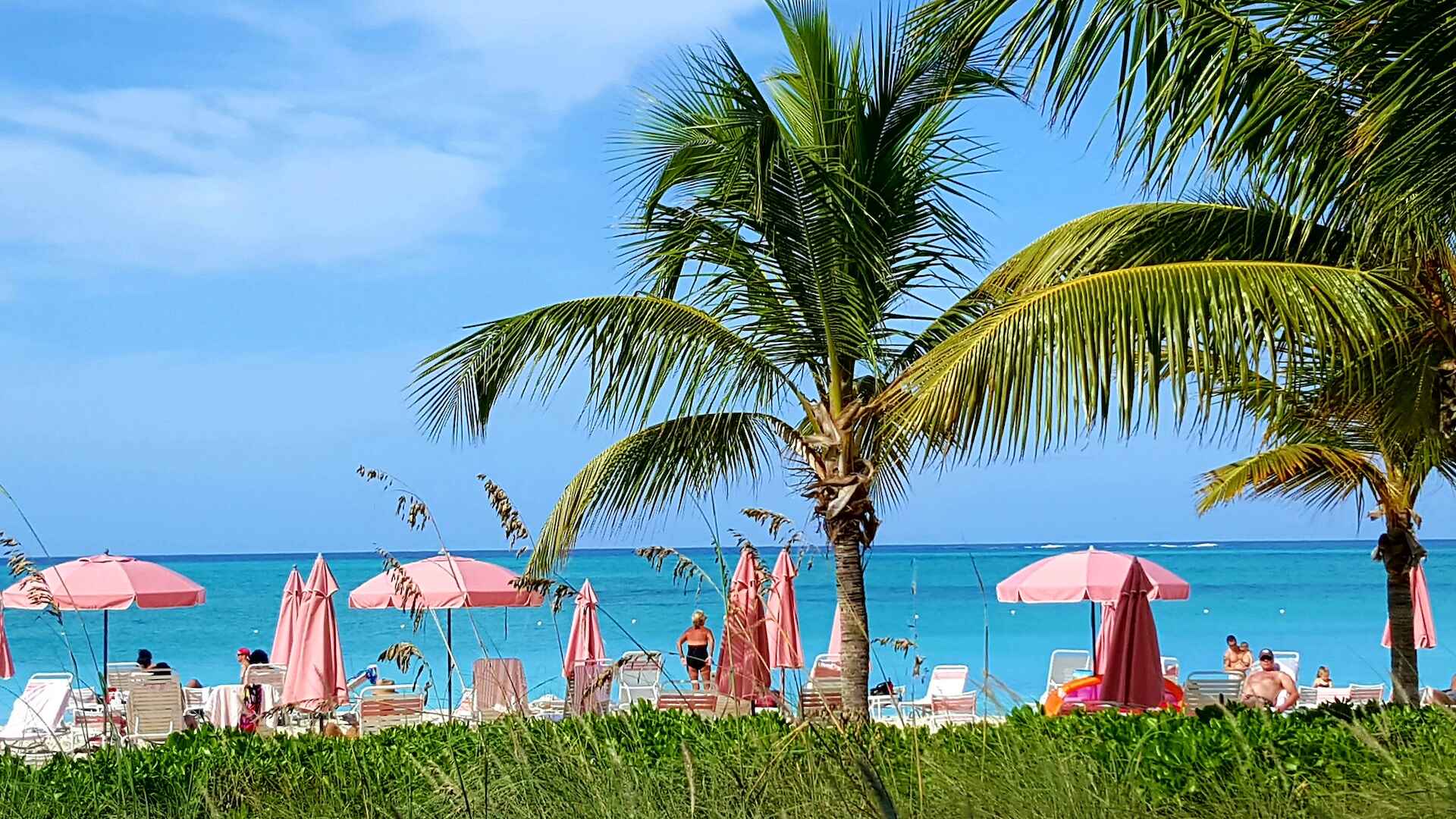Whether you're planning a romantic getaway, a family vacation, or a solo adventure, understanding the weather patterns of Turks & Caicos is key to making the most of your trip. Turks & Caicos, known for its pristine beaches and crystal-clear waters, also boasts a fascinating climate that shapes the unique experiences of each visitor.
In this guide, we'll explore the seasonal weather changes, the best times to visit, and what you can expect from this beautiful destination throughout the year. So, pack your bags and let's embark on a journey to discover the sunny skies and gentle breezes of Turks & Caicos!
Factors in Turks & Caicos's Weather Patterns

A signpost in Turks & Caicos
Welcome to the heart of our discussion on Turks & Caicos' weather! This beautiful archipelago is not just about stunning beaches and crystal-clear waters; its weather patterns are a fascinating mix of factors that create a perfect vacation climate. Let's dive into some key elements that shape the weather in this paradise.
The Tropical Climate: Sun, Sea, and Breezes
Turks & Caicos sits in a tropical climate zone. This means the islands enjoy warm, sunny weather almost year-round. Average temperatures hover around 85°F (29°C) in summer and 80°F (27°C) in winter, making it an ideal destination for sun-seekers.
Trade Winds: Nature's Cooling System
Trade winds play a vital role. These consistent breezes, coming predominantly from the east, provide a natural cooling effect. They make even the hottest days feel comfortable, perfect for lounging on the beach or exploring outdoor markets.
The Hurricane Season: A Factor to Consider
June to November marks the hurricane season. While Turks & Caicos doesn't often experience direct hits, it's important to be aware of this period. The islands are well-prepared for such events, and it's rare for hurricanes to disrupt vacation plans significantly, but it's something to keep in mind when booking your trip.
Proximity to the Equator: Consistent Daylight Hours
Enjoy consistent daylight. Thanks to its location near the equator, Turks & Caicos experiences about 12 hours of daylight throughout the year. This means plenty of sunshine for all your activities, whether it's an early morning dive or an evening stroll along the beach.
Ocean Currents: Influencing Water Temperatures
Warm seas invite you for a swim. The surrounding ocean currents play a significant role in maintaining the warm sea temperatures, typically around 75°F to 84°F (24°C to 29°C). These waters are not only inviting for a swim but also create a hospitable environment for diverse marine life, perfect for snorkeling and diving enthusiasts.
When Is the Best Weather for Visiting Turks & Caicos?

Ariel view of Turks & Caicos
Deciding when to visit Turks & Caicos largely depends on what you're looking for in your vacation. Whether you're after the perfect beach day, eager to explore the outdoors, or looking for the ideal time for water activities, understanding the weather patterns will guide your choice.
The Peak Season: December to April
The peak season, from December to April, is often considered the best time to visit. The weather is at its most pleasant, with minimal rainfall, plenty of sunshine, and comfortable temperatures averaging around 80°F (27°C). These months are perfect for those looking to escape colder climates. The seas are calm and clear, making it an excellent time for snorkeling, diving, and other water sports. However, keep in mind that this is also the busiest period, so you'll find more crowds and higher prices.
The Off-Peak Season: May to November
For those who prefer a quieter vacation and don't mind a bit of unpredictability in the weather, the off-peak season from May to November might be ideal. This period includes the warmer summer months and the start of the rainy season. While there's a higher chance of rain, showers are typically brief and refreshing, often occurring in the late afternoon or overnight. The ocean remains warm for swimming, and the beaches are less crowded. This is also when you might find better deals on accommodations and activities.
Hurricane Season Considerations
While June to November is hurricane season, Turks & Caicos rarely experiences direct hits. Travelers during this time should stay informed and consider travel insurance for added peace of mind. Despite this, many visitors find this period appealing for its tranquility and lush, vibrant landscapes following the rains.
Balancing Weather and Crowds
Ultimately, the best time to visit depends on your preferences. If you love sunny, dry days and don't mind the company of other tourists, aim for the peak season. If you're after a more laid-back, budget-friendly trip with a chance of rain, consider the off-peak months. Each season in Turks & Caicos has its charm, and no matter when you choose to visit, you're in for a treat with the island's natural beauty and warm hospitality.
When Is the Rainy Season in Turks & Caicos?

Sunet in Turks & Caicos
The rainy season in Turks & Caicos generally extends from late summer to early winter, typically spanning from September to December. During these months, the islands experience a higher frequency of rain showers compared to the rest of the year.
Nature of the Rainfall
It's important to note that the rain in Turks & Caicos usually doesn't mean day-long downpours. Instead, rain showers are usually brief and sporadic, often occurring during the night or in the early mornings. These showers can be quite refreshing, bringing a welcome respite from the heat and leaving behind clearer skies.
Impact on Daily Activities
For travelers, the rainy season should not be a deterrent. The intermittent nature of the rain means that you can still enjoy plenty of sunshine and outdoor activities. The seas remain warm and inviting, and the lush landscapes following the rains are a sight to behold. Additionally, the islands are less crowded during this period, offering a more peaceful and intimate experience.
Planning Around the Rainy Season
If your travel dates fall within the rainy season, it's a good idea to plan some flexible itineraries. Mornings are typically sunnier, so scheduling beach outings or boat tours earlier in the day can be advantageous. It's also the perfect opportunity to explore indoor attractions, like museums, galleries, or enjoying the local cuisine at the islands' excellent restaurants.
Advantages of Traveling During the Rainy Season
Besides the possibility of enjoying lower rates and fewer crowds, traveling during the rainy season allows you to experience a different side of Turks & Caicos. The landscapes are more vibrant and the atmosphere is more relaxed, making it ideal for those seeking a tranquil escape.
What Time of Year is Warmest in Turks & Caicos?

view_beach_turks_caicos.jpg
The warmest months in Turks & Caicos typically span from June to October. During this period, daytime temperatures average around 85°F to 90°F (29°C to 32°C), with the heat peaking in July and August. These months bring long, sunny days, making it perfect for sunbathing, swimming, and enjoying various outdoor activities.
Humidity and Heat
It's important to note that the warmth during these months is often accompanied by higher humidity. This can make the temperatures feel even warmer, so staying hydrated and protected from the sun is crucial. Fortunately, the ever-present trade winds provide a natural cooling effect, making the climate more comfortable, especially along the coasts.
Nighttime Temperatures
Evenings during this period are comfortably warm, with temperatures rarely dropping below 80°F (27°C). This creates ideal conditions for enjoying outdoor dining, beach parties, and night-time strolls along the shore under the starry sky.
Water Temperatures
The ocean water is particularly inviting during these months, with temperatures ranging from 82°F to 84°F (28°C to 29°C). This makes it the perfect time for snorkeling, diving, and exploring the vibrant marine life that Turks & Caicos is renowned for.
Travel Considerations
While this is the warmest time of the year, it's also part of the hurricane season. While direct hits are rare, it's wise to stay informed about the weather forecasts and consider travel insurance for peace of mind. Despite this, many travelers find this period ideal for experiencing the quintessential tropical beach holiday.
Seasonal Weather in Turks & Caicos

Turks and Caicos beach club
The ever-charming Turks & Caicos Islands boast distinct seasonal weather patterns, each bringing its own unique flavor and opportunities for visitors.
Winter: December to February
Winter in Turks & Caicos is characterized by cooler and drier weather, with average temperatures ranging from 75°F to 80°F (24°C to 27°C). This season is the peak tourist period, thanks to the comfortable climate and minimal rainfall, making it perfect for a wide range of beach activities and water sports. Nights can be slightly cooler, so packing a light sweater might be wise for the evenings.
Spring: March to May
As spring arrives, the weather becomes milder, with temperatures gradually increasing from the winter coolness to about 80°F to 85°F (27°C to 29°C). Rainfall remains scarce, ensuring plenty of sunny days ideal for outdoor adventures. The water temperatures start warming up, offering excellent conditions for swimming and snorkeling. Spring is an excellent time for those seeking to avoid the peak season crowds while still enjoying beautiful weather.
Summer: June to August
Summer in Turks & Caicos is the warmest and most humid time of the year. Daytime temperatures often reach 85°F to 90°F (29°C to 32°C). The season is characterized by occasional rain showers and thunderstorms, typically brief and refreshing. The warm sea temperatures are perfect for various water activities, including diving and exploring the vibrant coral reefs. Summer also marks the beginning of the hurricane season, so it's important for visitors to stay updated on weather forecasts during this period.
Fall: September to November
Fall signifies the rainy season in Turks & Caicos, with September and October experiencing the most rainfall. However, the rain showers are usually short-lived and don't significantly disrupt outdoor activities. The temperatures remain warm, hovering around 80°F to 85°F (27°C to 29°C). This is the least crowded time of the year, offering a more relaxed and intimate experience for visitors. The post-rainfall landscapes, lush and green, are a sight to behold, adding to the island's beauty.
Turks & Caicos: A Season for Every Traveler
As we wrap up our journey through the diverse weather patterns of Turks & Caicos, it's clear that this destination offers something special in every season. From the balmy and festive winter months to the vibrant and warm summer, each period has its unique charm.
Discover Turks & Caicos
Whether you prefer the tranquility of the off-peak seasons or the lively atmosphere of the peak tourist times, Turks & Caicos is ready to welcome you with its ideal blend of sun, sea, and sky. We hope this guide helps you plan your perfect island escape, tailored to your weather preferences. Remember, in Turks & Caicos, every day is a chance to experience paradise in its own special way. Happy travels!
All of our content at Caribbean Tourbase is written by experienced travel writers who have visited all of the locations we recommend. And our review board of local tourism experts ensure that all the information we provide is accurate, current and helpful
